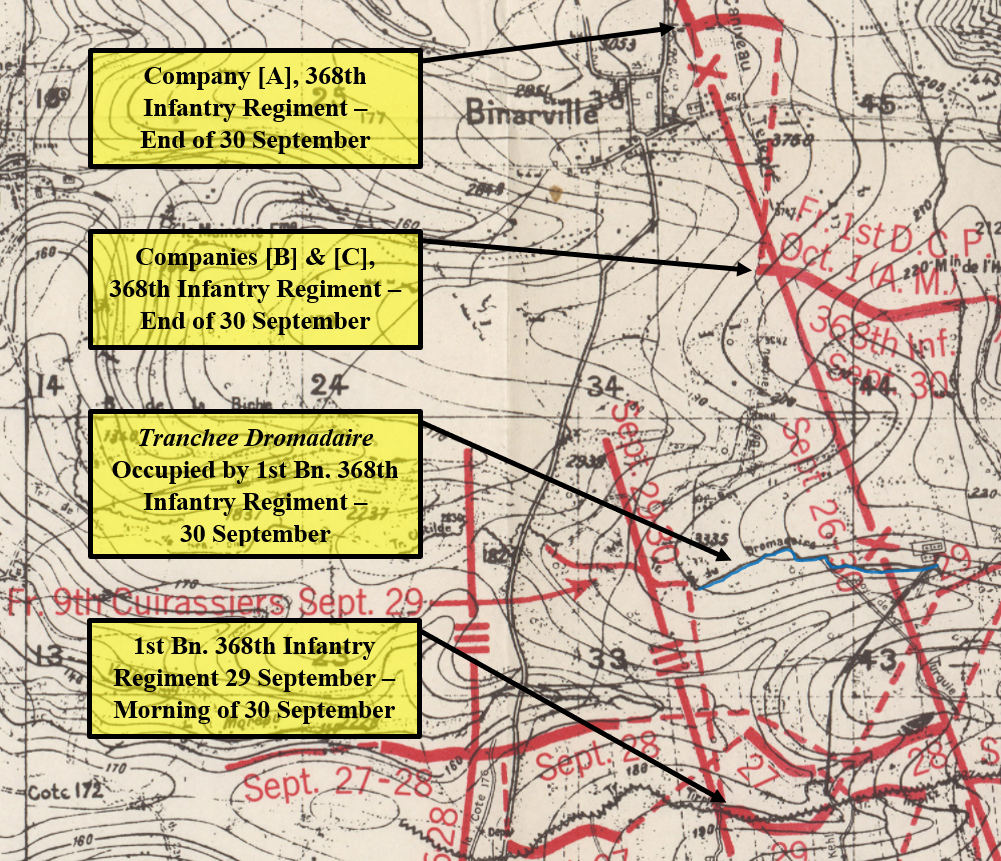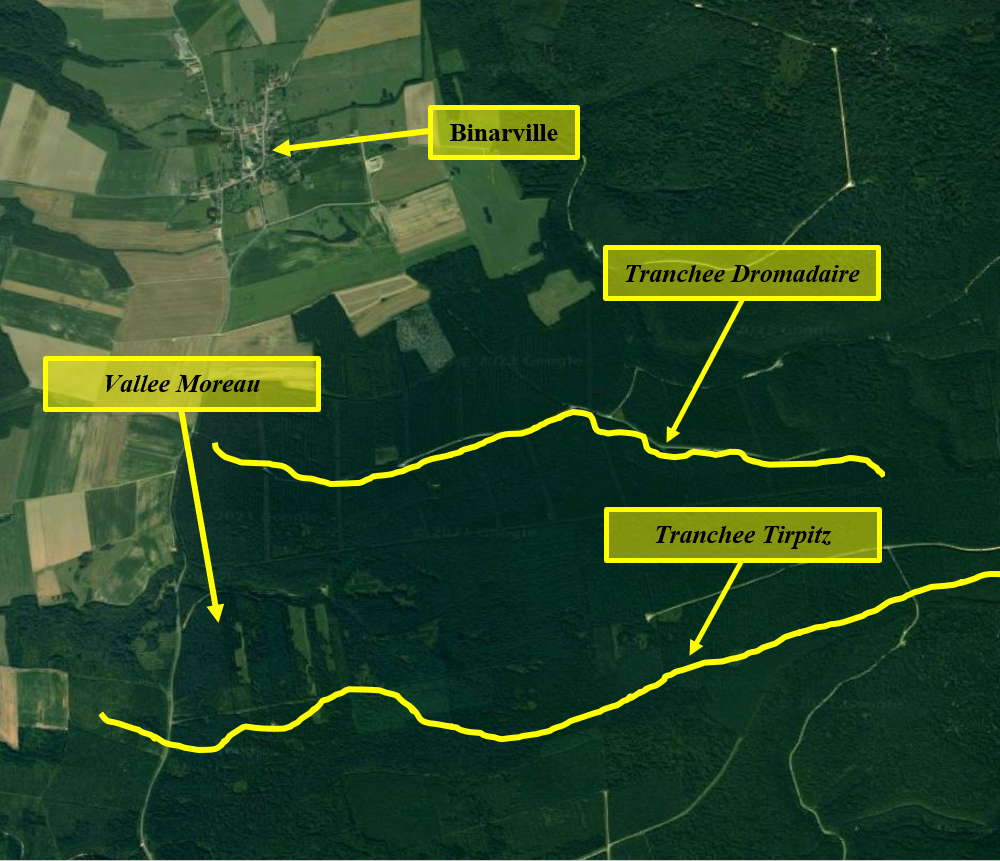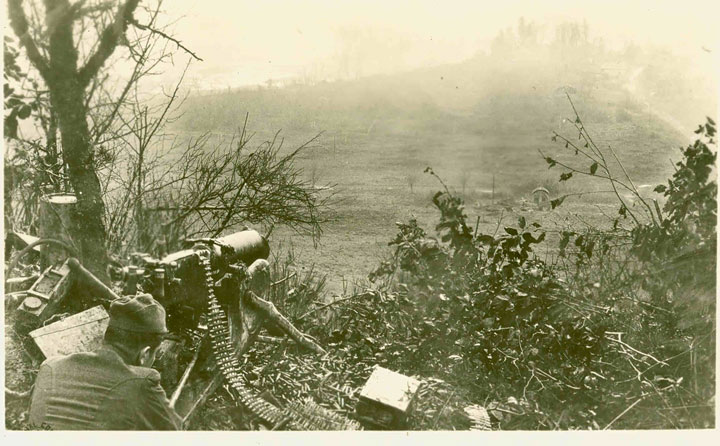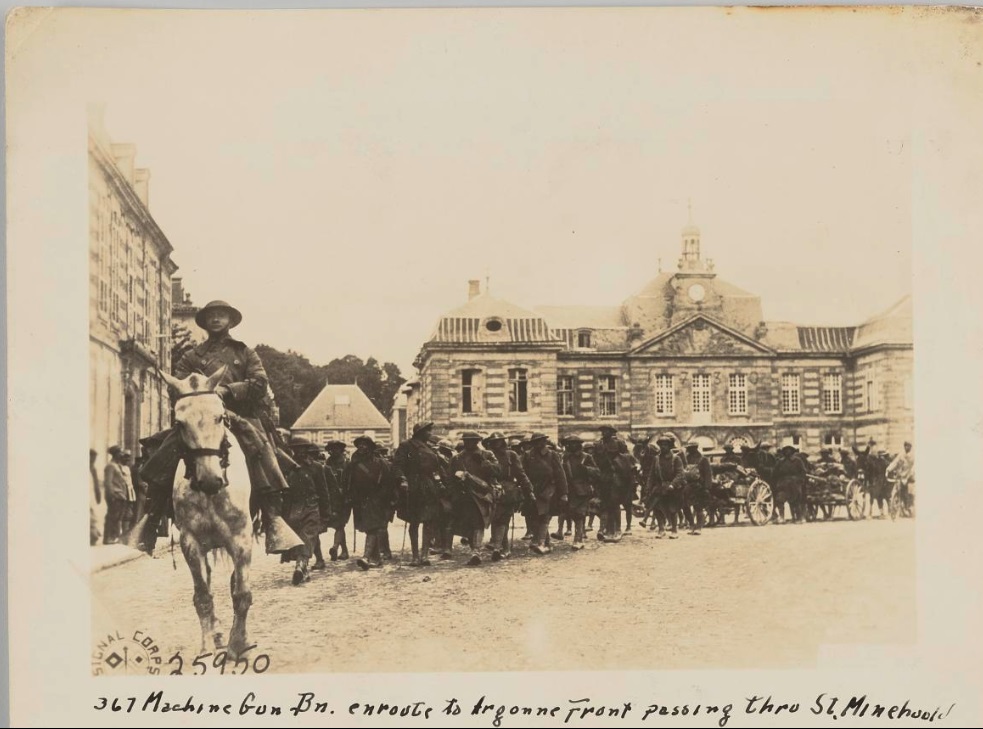Joseph James
Joseph James’ Personal Narrative was derived from information found in public records, military personnel files, and local/state historical association materials. Please note that the Robb Centre never fully closes the book on our servicemembers; as new information becomes available, narratives will be updated to appropriately represent the life story of each veteran.
Please contact the Robb Centre for further clarification or questions regarding content or materials.
Military Honor(s):
Distinguished Service Cross
Citation: The President of the United States of America, authorized by Act of Congress, July 9, 1918, takes pleasure in presenting the Distinguished Service Cross to Private Joseph James (ASN: 1798927), United States Army, for extraordinary heroism in action while serving with HQ Company, 368th Infantry Regiment, 92d Division, A.E.F., near Binarville, France, 30 September 1918. Private James went to the aid of a wounded companion under very severe machine-gun and artillery fire and brought him to cover. He stayed with the wounded man, giving him all possible aid until assistance came, when he returned to his place with the platoon.
Croix de Guerre with Silver Gilt Star
Life & Service
- Birth: 12 June 1895, Philadelphia, PA, United States
- Place of Residence:
- Race/Ethnicity: African American
- Death: 23 January 1986 Philadelphia, PA, United States
- Branch: Army
- Military Rank: Private
- Company: [HQ]
- Infantry Regiment: 368th
- Division: 92nd
Joseph James was born to Llewelyn (1869-1940) and Martha (Jones) (1868-1939) on June 12, 1895 in Philadelphia, Pennsylvania.
Joseph James enlisted in the U.S. Army on October 28, 1917, as a Private. Private James and his company left Hoboken, New Jersey on the U.S. Army Transport Ship George Washington on June 15, 1918, arriving in Brest, France on June 22, 1918. Private James received the Distinguished Service Cross for his actions on September 30, 1918 near Binarville, France;
“The President of the United States of America, authorized by Act of Congress, July 9, 1918, takes pleasure in presenting the Distinguished Service Cross to Private Joseph James (ASN: 1798927), United States Army, for extraordinary heroism in action while serving with Headquarters Company, 368th Infantry Regiment, 92d Division, A.E.F., near Binarville, France, 30 September 1918. Private James went to the aid of a wounded companion under very severe machine-gun and artillery fire and brought him to cover. He stayed with the wounded man, giving him all possible aid until assistance came, when he returned to his place with the platoon”. Awarded DSC by CG, AEF, December 6, 1918. Published in G.O. No. 35, W.D., 1919.
Private James and his company returned to the United States on February 15, 1919. James was Honorably Discharged on March 7, 1919 at Camp Meade, Maryland.
Private Joseph James served with the 368th Infantry Regiment Headquarters Company, 92nd Division. At the time of his act of valor, this unit was a part of Groupement Durand, a Franco-American provisional unit. The following is his story.
Binarville – 29-30 September
28 September, 1918

325 Field Signal Battalion, 92nd Division, Stringing Lines in the Argonne, near Binarville, 1 October, 1918.
While most of the 92nd Division was held in reserve of the American 1st Army through late September 1918, the 368th Infantry Regiment and two companies from the 351st Machine-Gun Battalion were partnered with the French 11th Cuirassiers. This ad-hoc unit, called “Groupement Durand,” was established to maintain liaison between the French 1st Dismounted Cavalry, French XXXVIII Corps, and the American 77th Division, American 1st Army, during the Meuse-Argonne Offensive. However, in order to do this the men of the 368th Infantry regiment had to advance over several kilometers of rough terrain, shattered woodland, and nearly 4 years’ worth of barbed wire and fortifications. This made progress through the Argonne Forest incredibly slow, and further made it difficult if not outright impossible to move heavy weapons, such as machineguns and stokes mortars, to support the infantry’s advance. To make matters worse, the 368th Regiment was also suffering from a severe supply shortage at the beginning of this operation, and thus entered combat without offensive weaponry, heavy wire-cutters, or even safe drinking water. As such, regimental organization and morale were severely impaired before the battle had even begun.
On 26 September 2nd Battalion, 368th Regiment, led the offensive but was quickly dispersed by heavy German machinegun and artillery fire. Much of the Battalion ended the day well behind the lines from which they had begun their advance. The morning of 27 September was spent reorganizing 2nd Battalion while 3rd Battalion, 368th Infantry Regiment, picked up the left flank, where [G] Company (2nd Battalion) had managed to gain some ground the day prior. Later that day, once 2nd Battalion reentered the battle, Groupement Durand (368th Infantry Regiment attached) made good progress – positions in and around Tranchee Tirpitz were taken and occupied overnight by multiple companies of the 368th Infantry Regiment. However, a continuous frontline had not been secured; the 368th Regiment’s companies were not only out of contact with each other, but liaison with the 77th Division to their right, which had been lost the day before, could still not be established.
On the morning of 28 September, Major Max Elser of 2nd Battalion again attempted to reconsolidate his forces. As he did so, 3rd Battalion resumed their offensive with French artillery support and reinforcements from the French 10th Dragoons. By midday, 2nd Battalion’s delayed advance became a problem, as the right flank of 3rd Battalion was exposed to the German in 2nd Battalion’s sector. Once at 1125 Hours (11:25 AM) and again at 1230 Hours (12:30 PM) Major Elser received urgent orders to hurry up and launch his own offensive, which would cover the advance of 3rd Battalion. However, when 2nd Battalion finally did resume movement that afternoon, they made little progress before they were again disorganized and withdrew under enemy fire. As their flank was thus unsecured, 3rd Battalion was also forced to withdraw to a safer position in the south of Vallee Moreau. Doubtlessly frustrated by Major Elser’s performance, Colonel Brown, the commanding officer of the 368th Regiment, had his subordinate officer sacked and replaced by Captain James T. Burns due to Elser’s “physical exhaustion” at 1700 Hours (5:00 PM). Regardless, by the end of 28 September the French judged that two of the 368th Regiment’s three battalions were no longer in fighting order, and began making moves to relieve the 368th Infantry Regiment from frontline service.
29 September, 1918
On the night of 28-29 September, 1st Battalion, 368th Infantry Regiment, was brought-up from the reserve to relieve the battered 2nd & 3rd Battalions. Additionally, the French 9th Cuirassiers were also sent from the 1st Dismounted Cavalry Division to reinforce the 368th Regiment, assuming control of the left half of their sector. Meanwhile, 1st Battalion was given control of a small section of frontline along Tranchee Tirpitz between the Boyau de Fribourg and the Boyau de Kehl. Under direct orders, the 368th Regiment did not undertake any direct offensive action, and instead 1st Battalion assumed a supporting role as the 9th Cuirassiers and 77th Division carried out a successful attack on Tranchee de Dromadaire, the final German trench between Groupement Durand and their ultimate objective of Binarville. By the end of the day, significant portions of Tranchee de Dromadaire were occupied by the Allied forces, which forced the Germans to abandon it on the night of 29/30 September.
That night, the rest of the 92nd Division, excluding the 167th Artillery, 317th Engineers, and 183rd Infantry Brigade were placed under the command of the French XXXVIII Corps. The 368th Infantry Regiment, up until now a part of Groupement Durand, was expected to rejoin their Division at Saint Menehould over the coming days as the French narrowed and consolidated their frontline.
30 September, 1918

Members of the 368th Infantry Regiment advancing on a camouflaged road near Binarville, 1 October, 1918.
While the 9th and 11th Cuirassiers began preparations for the final assault on Binarville, which was scheduled for 1200 Hours (12:00 PM), orders were sent out for the 368th Infantry Regiment to withdraw, except for 1st Battalion which was to maintain its line in Tranchee Tirpitz. However, the commanding officer of 1st Battalion, Colonel John N. Merrill, reportedly never received these orders. Instead, on the morning of 30 September, 1st Battalion, 368th Infantry Regiment, observed that the section of Tranchee Dromadaire to their front had been abandoned and moved to occupy this line. Thus, while 2nd and 3rd Battalions withdrew, 1st Battalion remained engaged.
The final assault on Binarville began as planned, and a rolling barrage from the French artillery demolished the German works in and around the town. As the shells pounded the earth, the French 9th and 11th Cuirassiers rapidly advanced over the open ground between Tranchee Dromadaire and Binarville, securing the defensive works to the south of the town. Having observed this offensive from his Battalion’s forward position, Colonel Merrill gave the order for his own soldiers to join the attack at 1400 Hours (2:00 PM), and at 1600 Hours (4:00 PM) a combined force of the 9th Cuirassiers and Company [A], 368th Infantry Regiment, established a line just north of the town. Meanwhile, Companies [B] and [C], 368th Infantry Regiment, advanced to the town before being forced back to safer positions just to the south by devastating German machinegun and artillery fire. Ironically, Companies [B] and [C] were able to establish liaison with the 77th Division from this position for the first time since Groupement Durand initially lost contact with them at the beginning of the Meuse-Argonne Offensive, despite being out of contact with the rest of their own regiment. By the time that contact was reestablished between 1st Battalion and the rest of the 368th Infantry Regiment at around 2030 Hours (8:30 PM), it was decided that Colonel Merrill’s men should hold their position for the time being, and the 367th Infantry Regiment, 92nd Division was mustered to support them. However, at 2200 Hours (10:00 PM) the French XXXVIII Corps informed the 92nd Division that further offensive action from them would be unnecessary, as the frontline had narrowed following the capture of Binarville.
While the exact details of Private Joseph James’ actions on September 30 remain shrouded in mystery, the fact that he was a member of the 368th Division’s Headquarters Company suggests that he may have been a runner sent to locate the missing 1st Battalion following their unexpected part in the capture of Binarville. What is known is that, upon seeing a wounded soldier in no-man’s-land, Private James heroically came to the man’s aid and brought him to safety under heavy fire from artillery and machineguns. There, as shells burst around them and the German guns tore at the Earth, Private James stayed with the wounded man until, at last, help arrived.
For this courageous act of compassion, Private Joseph James was awarded the Distinguished Service Cross on December 6, 1918, under General Orders No. 35.
James worked as a firefighter at the (present-day) Henry C. Mustin Naval Air Facility in Philadelphia, Pennsylvania in the 1920s, a trackman at a railroad in the 1930s, and at the Schlichter Jute Cordage Works in the 1940s. Joseph James died on January 23, 1986, unmarried, with no children.




